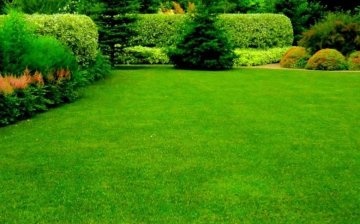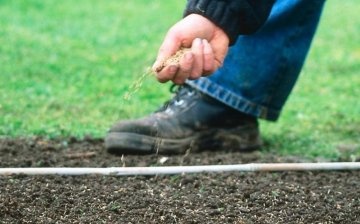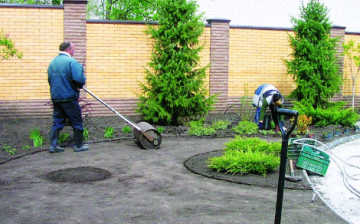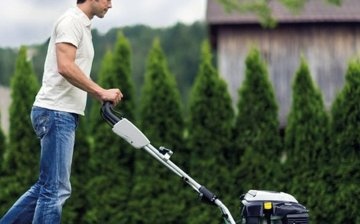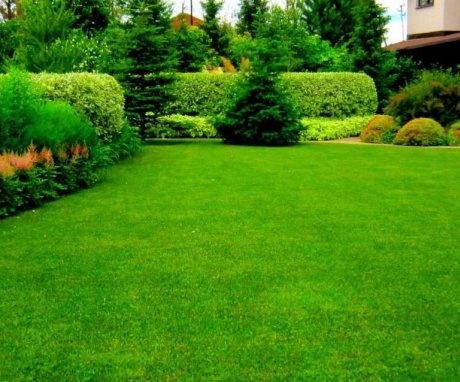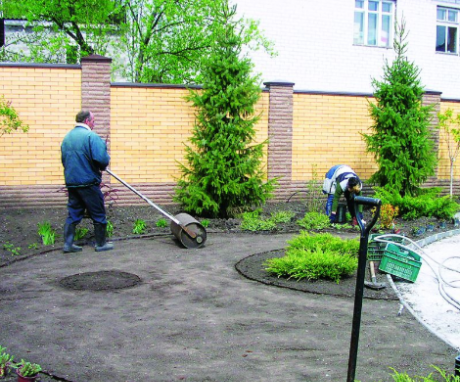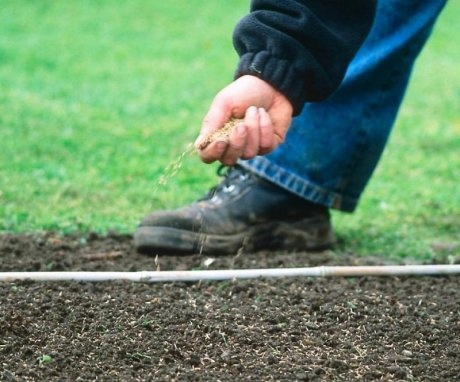How to make a lawn on your own plot from scratch
Arranging free space in the courtyard with a lawn not only improves the landscape of the site. Fresh green grass purifies the air, releases oxygen, which is so necessary for the health of children and adults. The article tells you how to make a lawn correctly with a minimum of costs.
What you need to make a lawn with your own hands
If there is a desire to equip a part of the local area with a lawn, you need to decide what area the site will be, and whether there is a technical possibility to provide proper care for the greenery. You need to start work with drawing up a project. It indicates not only a scaled site plan, but also an accurate description of the type of lawn, supply of communications and cost calculations.
The main points that should be taken into account when developing a project:
- choice of location;
- scope of work on soil preparation;
- type of lawn grass;
- the purpose of the lawn;
- where to buy seed;
- consumption for seeds, fertilizers and other decorative elements (lighting, irrigation system, cutting equipment).
Reference! For arranging the lawn, seed and roll material are used. You will have to tinker with the first option, but it will cost an order of magnitude cheaper. Rolled grass is a fast and expensive way to domesticate a site.
Site requirements
Choosing a site for lawn, you need to take into account that each type of grass requires certain conditions. For example, for an English lawn, the absence of wind and shade is important. Plants grow well in secluded corners of the yard. Also, places are not suitable for almost all grass crops in the immediate vicinity of buildings and in an area of constant shade.
If you plan to set up a lawn under fruit or ornamental trees that have a dense, large crown, the chances of a normal vegetation of the lawn vegetation are low. This is due to the following factors:
- tree roots will take the lion's share of the nutrients on themselves;
- branches with foliage create a dense shade, which slows down the process of photosynthesis of the grass.
Experts do not advise choosing a site for a lawn in a lowland, where a high level of moisture is usually noted. The root system of greenery will rot in such conditions.
When choosing a place for a lawn, attention is also paid to the type of soil. If it is dense, clayey, then there is a need for a drainage arrangement. This expense item should be provided if the climatic features of the region include frequent precipitation or flooding.
When determining the area for sowing lawn grass, it is recommended to avoid areas with elevation differences. In such places, the soil is often subject to erosion and leaching. If you cannot find an alternative site, the bumps should be leveled so that the steepness does not exceed 30 degrees. To prevent the encroachment of the earth, a reinforcing mesh is installed. The metal frame will reliably hold the soil, not allowing it to crumble.
A site on which cars and people move every day is not suitable for sowing. Even a grass mixture under a sports lawn cannot withstand such loads. An alternative option for landscaping such a site is laying paving slabs under the paths and wheels of a car.
Preparatory work
It is better to do project development in winter. There will be time to calculate everything and reflect on the layout. With the onset of spring, you can start excavating.It is this period that is considered the most favorable for the rapid germination of seeds and the development of greenery. The soil has not yet dried up after winter, the solar activity is moderate. If the moment is missed, it is better to wait for autumn.
Before sowing grass, the soil must be carefully prepared. This process consists of the following steps.
- Clearing the territory. All debris, plant debris, stones and other rubbish must be removed from the site. If there are stumps, it is better to uproot them. Otherwise, they will complicate lawn care. If there are trees, the branches located on the lower tier are pruned. This will open up the sun's rays to the grass.
- Weed control. Weeds are picked by hand or etched by chemical means. When choosing the second option, it will be possible to start sowing in 1-3 weeks. It is better to carry out chemical treatment in the fall, then the favorable time for sowing will not be missed.
- Drainage arrangement. If the site is exposed to waterlogging due to the high occurrence of groundwater or a large amount of precipitation, there is a need for a drainage system. To do this, a pit 30 cm deep is dug in the area under the lawn. In several places, holes are made 50-70 cm deep (along the perimeter and center). The depressions are covered with gravel. Then, all over the site, they are laid with a layer of crushed stone (10-15 cm) and sand (10 cm). Further, fertile soil is laid (from 20 cm).
- Relief leveling. If a drainage system was equipped, there is no need for alignment. After laying the layers, the area becomes even without that. In other cases, the soil is dug up with immersion on the bayonet of the shovel. Until the earth is dry, you need to carefully break up large lumps with a rake or pitchfork.
- Fertilizer. To increase the fertility of the soil, it is recommended to feed it with humus or mineral fertilizers. Do not use fresh manure. It attracts pests, provokes the decay process, which is dangerous for the root system of lawn grasses.
- Soil compaction. Before sowing, the site is harrowed. If there is no special skating rink, you can use a large log. It is pulled several times over the leveled area to compact the soil. The quality of work is checked as follows. If, after passing through the site, there is no deep imprint of the sole, proceed to planting.
Reference! After harrowing, you need to lightly walk around the site with a rake. This will allow the seeds to sink into the soil.
Lawn grass selection
The key to a successful lawn is the right choice of grass. It should definitely be a long-term culture. It makes no sense to do large-scale work annually. Of the large number of varieties, preference should be given to cereals, since they are most adapted to our climate.
Seed requirements:
- resistance to freezing;
- the ability to build up a strong root system;
- high speed of cover build-up after mowing;
- the ability to reproduce in a vegetative way.
There are many varieties of lawn grass, but the following species fully meet the above criteria: red fescue, bent grass, meadow bluegrass.
Table 1. Popular types of lawn grass.
|
Name |
Characteristic |
|
Swamp bluegrass |
Suitable for soils with high humidity. The culture forms a dense green carpet. The root system is well developed. The disadvantage is the short life span. It is recommended to periodically re-sow or combine grass with white bent. The life cycle of a lawn is 5-8 years. |
|
Polevitsa dog
|
Suitable for creating a parterre lawn. You cannot walk on it. But the result is a highly aesthetic emerald-colored coating with thin blades of grass, delicate to the touch. The culture is capricious, the life span is 4-5 years, the root system is poorly developed. The grass grows slowly. |
|
Meadow fescue
|
More often, the variety is included in herbal mixtures.This is an aesthetic culture that grows quickly, densely spreads over the site. The disadvantage is a short life span (up to 4 years). |
Lawn types
Which type of lawn to choose depends on its purpose. Depending on the intensity of movement on the green area, the type of mixture of herbs and the percentage of each crop are determined.
- Sports lawn. This type of turf is suitable for a children's area, playgrounds, places for walking pets. The composition of the mixtures includes non-trampled crops, which will exclude the rapid formation of bald spots. Distinctive qualities of a sports turf: dense coverage, tough grass, unpretentious maintenance. At the preparation stage, they equip a solid substrate.
- English (parterre) lawn. It is a landscape object that serves a purely decorative function. You cannot walk on it. The coating is gentle, afraid of trampling. The grass requires careful maintenance so that the lawn always has a pretentious look.
- Garden and park lawn. It is this option that is most preferable for giving. The crops included in the herbal mixture are characterized by unpretentiousness, the ability to grow on poor soils. A garden and park lawn is being set up near a recreation area, a reservoir and a swimming pool.
- Meadow lawn. It is also called Moorish. The mixture of herbs contains flowering crops. The green coating looks interesting in combination with small bright inflorescences. When compiling mixtures, plants with different flowering periods are selected. Therefore, it is fascinating to observe the lawn throughout the warm season. The palette of colors is changed every month. It is rarely necessary to mow the meadow cover, mainly to clear the site from faded plants. Walking on the grass is not recommended. Trampled grass is unlikely to be restored.
- Versatile lawn. Such lawns are created quickly thanks to the use of rolled grass. They are realized with a sod layer, which ensures quick adaptation to a new place. This option is suitable for all types of soil. The main purpose is recreation areas with the ability to move on the grass. Roll material is not suitable as a decorative lawn due to its low aesthetic properties.
Rolled lawn is more expensive than sowing. Features of this type: the need for special preparation of the site, compliance with the rules for laying grass rolls.
Sowing instructions
Sowing grass is carried out in this order:
- using a fan rake to level the platform (the surface should not have bumps and depressions);
- sow planting material in compliance with the norms per 1 m2 indicated on the package (done manually or using manual seeder);
- roll in the area with a roller or log (you can use the reverse side of the rake);
- water the planting using the sprinkling method (the jet must be sprayed).
Reference! If sowing small grains is inconvenient, they are mixed with sand to evenly distribute the material over the site.
When seeding by hand, it is recommended to pass the site several times in different directions. First, you should move from left to right, then diagonally. This scheme ensures an even distribution of seeds over the area allocated for the lawn.
Further lawn care
For the normal development of the root system and intensive growth of the green mass, it is necessary to ensure regular watering. Weeds are periodically removed from the site, which can suppress the fragile lawn. As the blades of grass grow, they are trimmed using special tools or equipment. Mow the green carpet so that 5-10 cm remains.
A lawn grown for 2-3 years is considered mature.
Irrigation system
The irrigation regime is compiled taking into account the season, weather conditions, soil type. It is problematic to derive a specific irrigation rate. Water the lawn regularly, but do not overdo it. If puddles form on the site, the root system will rot.
Before irrigation, it is recommended to check the degree of dryness of the soil at a depth of 7-10 cm. If this layer remains dry after irrigation, the amount of water should be increased.
When hot dry weather is established, the lawn should be watered at least twice a week. In cool weather, once every 10 days is enough. If the land has not dried out before the next irrigation, it is worth revising the regularity of moisture.
Reference! Soil drying out problems do not occur on loams or alumina.
Watering is organized in the following ways:
- a garden hose with a spray (preference is given to multilayer products with a reinforcing layer);
- automatic irrigation system (presence of sprinklers);
- non-adjustable pivots (suitable for small lawns);
- movable models, alternately moisturizing all zones of the green cover;
- underground irrigation systems (it is difficult to equip them, engineering knowledge is needed).
A haircut
It is necessary to cut the grass not only to maintain the aesthetic appearance of the lawn, but also to stimulate the vegetation processes. This procedure activates the formation of bushes, the growth of rhizomes, which create a dense turf.
The haircut is done in dry weather. Mower blades dull less when working in the morning or evening when the grass is covered with dew.
When mowing regularly, point the tool in different directions. After the passage of the machine, the grass tilts in the direction of the vehicle. It is necessary to change the trajectory of the mower to level the cover.
It is advisable not to skip areas of the lawn, so as not to provoke the formation of bald spots. The so-called bald patches appear as a result of insufficient penetration of light into the lower part of the plants.
After shearing, the grass is harvested. It can be composted or used for other purposes. In hot weather, the mowing is left on the lawn for 2-3 days to protect the soil from drying out.
How often you cut your hair depends on the type of grass and other factors. Usually the procedure is performed every 2 weeks.
Features of care at different times of the year
Lawn maintenance activities are determined according to the season.
- In the spring. During this period, fallen leaves and debris are collected. The cleaned area is fertilized with nitrogen-potassium agents. Thorough aeration is carried out to enrich the soil with oxygen. Watering regime with low sun - once a week. As the grass grows, the lawn is mowed. Found bald spots are sown with a new portion of seeds.
- Summer. A dense lawn should be periodically combed. At this stage of the growing season, it is recommended to introduce nitrogen-potassium supplements. Watering is carried out at least 1-2 times a week. The grass must be cut regularly (the height of the blades should not exceed 5-10 cm).
- In the autumn. From the lawn at the end of the warm season, you should rake the fallen leaves. It will not be possible to do this once, since the leaves fall off within 1-2 months. Therefore, combing the lawn is carried out once a week. Phosphorus-based formulations are used as fertilizer in the fall. Watering the lawn in the absence of precipitation is carried out at least 1 time per week. For the winter, the grass is cut, leaving a height of 10 cm.
What mistakes should be avoided
Those who have not gained experience in creating a lawn often make gross mistakes. When planning and performing work, it is important to pay attention to the following issues:
- the choice of grass - before buying it is worth clarifying whether the growing conditions are considered favorable, whether they correspond to the climate of the region;
- selection of fertilizers - you should not give preference to a certain microelement, it is better to use complex compounds rich in sodium, phosphorus and other substances;
- improper watering - after the appearance of greenery, daily irrigation is required, but at the same time it is necessary to control the amount of water in order to prevent decay of fragile roots;
- mowing mode - the lawn is cut when it is still young, but it is not necessary to bare the cover, 3-5 cm of grass should remain above the soil surface;
- preparation for the new season - it is generally accepted that feeding and cutting are not needed in the fall, these are gross mistakes that lead to the formation of bald spots and drying of the grass.
Reference! Don't skimp on seeds or work. Violations of certain rules of agricultural technology will reduce to zero all other costs.
How much does it cost to make a lawn at a summer cottage
When arranging a lawn in the country, the main costs are for seed and fertilizer.
|
Lawn Grass Prices |
||
|
Lawn type |
What varieties are included in the complex |
Cost per 1 kg, rub. |
|
Sports |
Fescue - 40% Pasture ryegrass - 10% Meadow fescue - 20% Meadow bluegrass - 10% Reed - 20% Red fescue - 20% |
250 |
|
Universal |
Pasture ryegrass - 20% Timothy meadow - 20% Reed fescue - 20% Annual ryegrass - 20% Meadow fescue - 20% |
180 |
|
Country carpet |
Pasture ryegrass - 50% Red fescue - 20% Meadow fescue - 20% Meadow bluegrass - 10% |
255 |
First of all, the amount of grain is calculated. Approximately 20-35 grams are spent on 1 m2. Consumption for a plot of 10 m2 is on average 300 g. To this amount you need to add 30% for sowing bald patches, which always appear after germination of greenery. The total is 390 g per 10 m2.
You also need to take into account the costs of preparing soil fertility. This will require humus. For a bag of fertilizer they ask for an average of 150-200 rubles. One bag is enough for about 10 m2. If the soil is acidic, you will need lime to neutralize the medium (plus 500 rubles for a 25 kg bag).
Fertilizers with seeds are delayed by an average of 300 rubles. And this is an expense only for a lawn of 10 m2. If the sowing site is equipped with a border and other decor, the cost increases in accordance with the project estimate.
When ordering work through a company, the cost is calculated taking into account the following types of work:
- land cultivation;
- weed removal;
- leveling and compaction of the soil;
- sowing seeds;
- seeding.
Total processing of one hundred square meters will cost 10,000 rubles. To this amount are added the costs of drainage, seeds, fertilizers and decoration.
Difficulties in the work on arranging the lawn will not arise if the process is broken down into stages. It is better to perform them in a measured way, enjoying the outdoors.
Video instruction for sowing a lawn:



